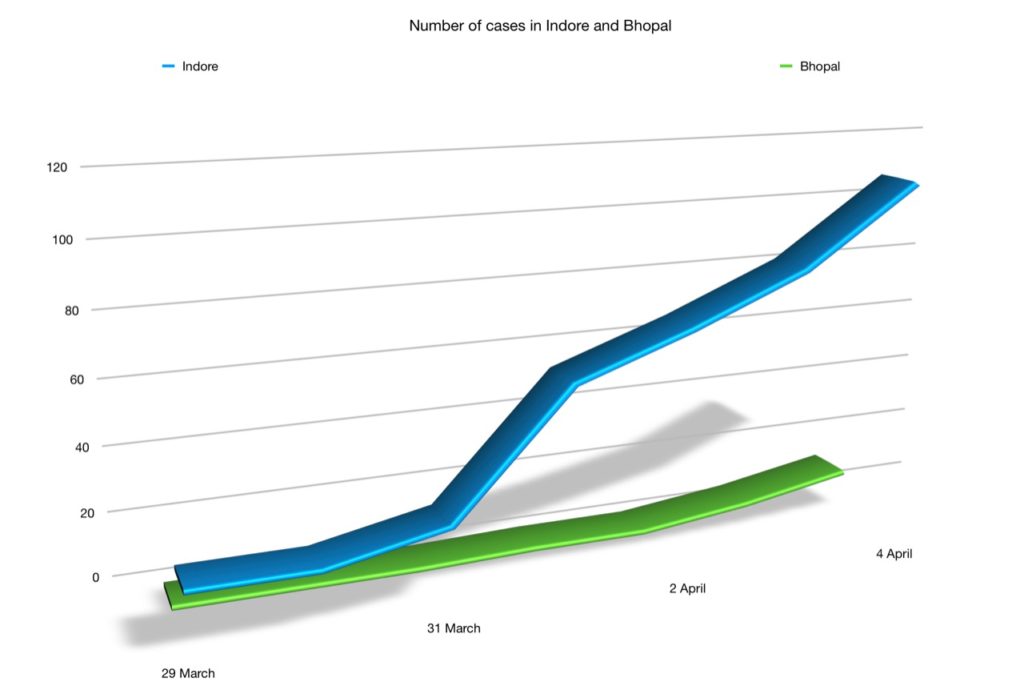Both Mr. Jain and Dr. Bhandari find the city’s local administration and state machinery acting in tandem up to its optimum at the given moment, but that wasn’t the case since always, with its remnants halting and haunting the city’s COVID-19 fighting prospects even now.
“There was a lot of carelessness in the beginning. We were told that two CoVID patients ran away from the hospital, and that abscond couldn‟t be caught up on time,” Dr. Bhandari adds.
“There was a lack of coordination between city’s local medical machinery and state administration when the initial few cases were being reported. There was a communication gap – and the top medical officers didn’t communicate to the state’s police about the level of strictness required to enforce the lockdown given the speed at which infections started being reported,” Mr. Jain told Jan Ki Baat.
On 20th March, 2020, Indore recorded Madhya Pradesh’s first COVID positive case – by 25th, the city ended up reporting four coronavirus cases with no traceable foreign travel history. At the same time, the rest of the urban centers and towns remained relatively unpenetrated by the contagion.
Dr. Bhandari finds the chaos in Madhya Pradesh’s power circles partly responsible for the contagion mess her city has fallen into –which is sweating up the administration to get out of it at the moment.
Why Indore’s COVID-19 graph is worrisome – the Italian cautionary context.
Lodi and Bergamo, located barely 75 kilometers from each other in northern Italy, looked at first to be on near-identical infection trajectories. Both are small states of sizes roughly that of Indore and Bhopal.
Both saw infections steadily rise throughout late February and early March.
According to New York Times, on March 8, Bergamo’s infections rose exponentially, doubling in just a few days, then doubling again. Hospitals became like trenches in a war zone. Deaths became so numerous that the military was sent in to relieve the overburdened morgues. It became Italy‟s hardest-hit province and, for many, a symbol of the country’s trauma.
Lodi’s confirmed infections, meanwhile, began to level off. As infection rate rose in the country, Lodi saw its curve bend.
The scale varies, but the graph of Indore is en route the Bergamo path – whereas Bhopal’s is leveling off just like Lodi.

What happened on March 8? That was the day Bergamo was put under a severe lockdown.
The crucial moment had come two weeks earlier, on Feb. 23, according to a study by Oxford University‟s epidemiologists and Health experts.
What was little understood at that point, or at least poorly appreciated, was that two-week lag between when an infection occurred and when it was recorded.
Lodi’s measures might have begun working immediately, but infections that took place before Feb. 23 continued to emerge for two weeks afterward, making the policy look as if it had failed. It was not until March 8 that the apparent decline in new infections was reflected in the numbers.
In Bergamo, during those same two weeks, what looked like a few hundred cases had probably, by the time that the lockdown was imposed on March 8, already spiraled into thousands.
Lodi and Bergamo are worth keeping in mind as we watch how the mayors of Indian cities and administrations of the states respond to the very first cases in their cities and states.
Are they choosing to be Lodi, and to look foolish followed by saviors within a short span of 2 weeks? Or are they choosing to be Bergamo? Indore needs to be over reactive to prevent a catastrophe.

